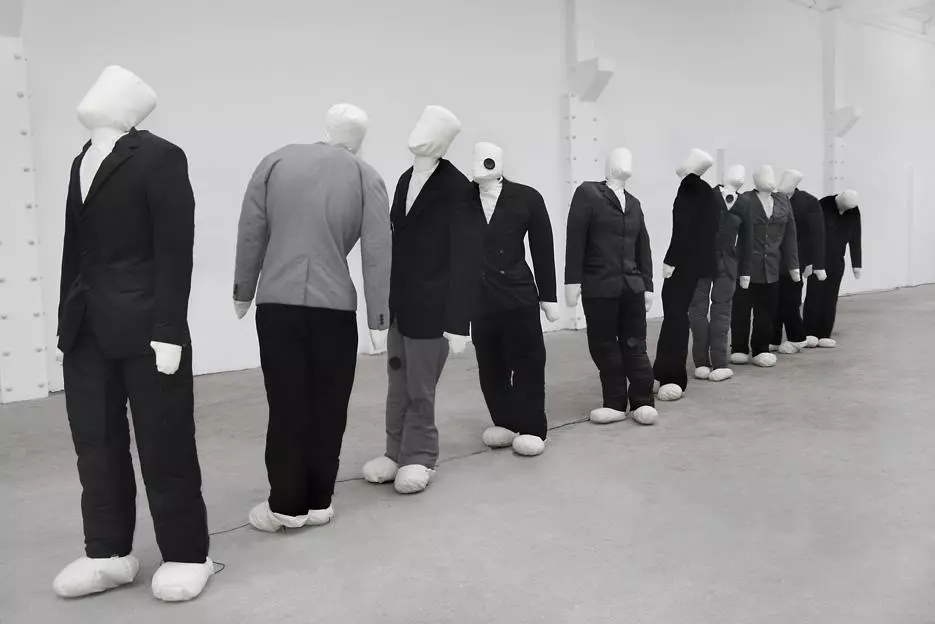Goran Despotovski has established a specific model of non-conceptual research, determining the relationship between object and figure and, accordingly, effects of the body/figure between poor art, the performativity of action art, the affectivity of new media and the analysis of everyday modern life conducted in the context of cultural studies. Despotovski began his explorations in a domain of locating the paradoxical border between figurative and primary painting in the late 1990s, doing later his research in the field of complex object-related figurative, corporal and representative installations. Instead of aesthetic-artistic, respectively, cultural or politically explicit statements there are only consumed pale notions in his work, or in the true sense of Jacques Derrida: the erased traces of existence, in other words, of the human body in its existence.
A series of new works, prearranged for this exhibition, focuses on two related existential moments on “a figure among figures” that allegorizes a man in the crowd and on a growing sense of alienation that becomes visible by the appearance of the work. Despotovski works with figures that are not sculptural or pictorial mimesis of the human body but “marionettes” that are simulacrums of ghostliness and absence of human life amidst human life, i.e. amidst human sociability, hence, amidst the politics of everyday life. The artist inscribed once on a piece of work “Human beings – figures - dolls are being stopped in a confused and dement state within their interrupted action and act, transmitting collective warning from the past. These works, allegorical and symbolic, impel their spectator to identify with them and to reexamine one’s own position in the society, which has been placed into a situation of permanent crisis at the global level and which values have been very often perverse.”
Despotovski places emphasis on the role of appearance, in the first place on a sensual tangible-visible demonstration of alienation representing a social state of human being in which one’s own wishes, fantasies, behavioral models, ideologies, religious convictions and the products made out by one’s own effort, as well as one’s own everyday life, have become alien and incomprehensible. Schematically speaking it can be said that (1) the cause of alienation is not anymore the human labor or the separation of subject from the object which he produces; (2) this kind of alienation is prevailed by imposing the object as a piece of information on the subject and on the subjects in relation to each other. A human being is the separate “object” itself who produces an ecstatic – virtual, figure-oriented, screen-like, marionette-like – system of effects emerging from the object and/or from the information about human life presented by senses. Literally, a man is not anymore a biological organism only. Human being – figure – marionette in Despotovski’s works is a system of fragmentary relationships of objects linked into a regulatory system of control, supervision, exhibitionism, disappearance, hiding and the impossibility of a real lively communication.
The latest accomplishments of Goran Despotovski enter the field of critical analysis, raising issues of “relational aesthetics” and provocative confrontation with the “ghostly” and “perverse” effects of growing alienation of humanity:
The installation Insult (2008) is assembled by a great number of – a crowd of – thrown “naked” dolls, i.e. by 150 thrown away pieces-figures. These dolls form a crowd, suggesting an effect of theatricality of thrown human beings, of dead bodies, of the rests of the human bodies after mass crime etc. They are – erased or pale figures “made of” human beings, having no identity, a particular countenance or singular character anymore. As if the biopolitical idea of loss of life “itself” or “bare” life is allegorized here. The dolls are in natural size of a human, made of a white silicone substance, producing thereby an effect of the rests of human bodies.
The installation Mumbled (2007-2008) is composed of ten dolls without faces, made in natural size, which are wearing everyday male clothes. The dolls are placed in a regular line. One doll is standing in front of or behind the other. The line is set up as “a line” of a mass or group of people waiting to enter a bus, a museum, a consulting room, court interrogation, a bank, a post office etc. On the other hand, the line is slightly chaotic. Set up of figures, it is, indeed, abstract - it might have been set on every place at every time, being, nevertheless, very concrete – it is set here, placed in front of the spectator in all its presence. The figures emit an indistinguishable speech, a kind of mumbling or a murmur. This sound creates a confusing situation being very familiar and very unclear at the same time, which is hardly part of everyday experience even though resembling it.
The installation Plasma (2008) is set up as a sort of a stylized plane vehicle, a particularly designed stage barrier which divides the space into two parts. The vehicle/barrier is made of the bed lined that became dirty by its past uses. On the both sides of the “vehicle/barrier” there are two figures wearing a black male suit. They are gazing into the white cloth of which the vehicle/barrier is made. The traces of everyday life, dirty whiteness, emptiness and absence.
The wall installation Civil (2008) is made of five or fifty white flags on which plane figures and black flaws, referring to the clothes without the body, are shown. They are silhouettes in motion. Phantomlike bodies are “caught” and placed on the flag in order to symbolize absent, lost, what is deficient, almost tragic. In the majority of his works Despotovski develops visual and spatial dramaturgy of “tragic alienation”, which is rhetorically enhanced by the non-presence of life in the field of visible, corporal and human. If the life is present, like in the installation Boiling (2007-2008), it is brought to a mechanical spasm emphasizing the “cursed” life itself, reduced to elementary and trivial actions, situations, events or relationships. In Boiling, two bodies, worn underwear, are set in the lying position on a big bed where they “boil” – the sounds of urinating and passing gas are emitted by the dolls. The video work To Float (2008) shows a piece of drowned fabric, tied by the strings that move it. This process has a dramatic flow of floating strengthened by the sound of splashing water. The shape of the fabric, similar to the jacket, represents a man as a non-corporal appearance being in the stage in-between, neither up nor down; neither live nor dead; neither drowned nor rescued; nothing but being in the stage of floating. That is the “life” that moves on in a marionette-like manner of being and not being here. To move on and to imitate moving on. It seems that there is no difference, no distance, between presence and the illusion of presence.
Goran Despotovski focuses in his work on perverting the human boundary of “life”. Life is not a nucleus of existence but minimal resistance to alienation. If there’s no resistance, the world of dolls/marionettes shows up. The dolls/marionettes are here, as ghosts they are not here.
Misko Suvakovic
 Share / Save
Share / Save






Commenti 0
Inserisci commento